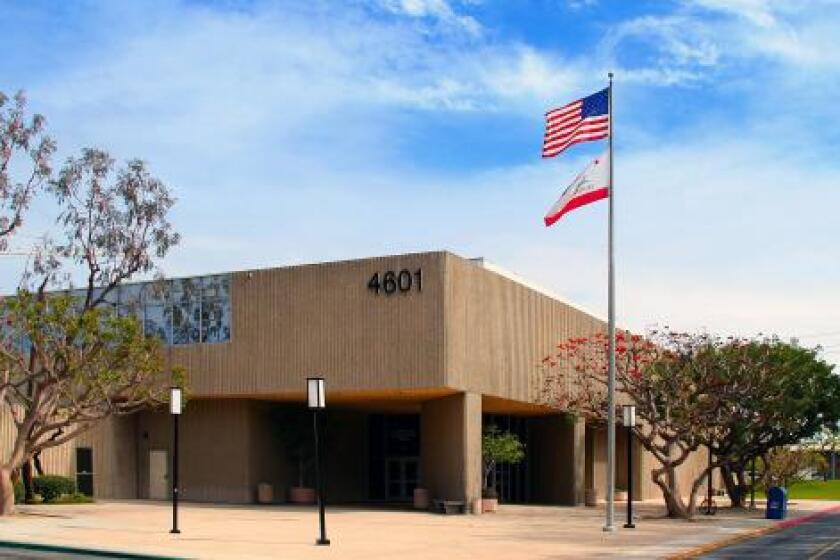NATURAL PERSPECTIVES:
- Share via
As inveterate procrastinators, Vic and I decided to attend a Yellowstone Assn. wolf and bear workshop only a few weeks ahead of its June 10 start date.
These tours generally sell out many months in advance. If some other family hadn’t canceled shortly before I called to make our reservations, we couldn’t have gone. Talk about luck.
Our group of 11 gathered the first evening at the Mammoth Hot Springs Hotel and Cabins to meet Yellowstone Assn. naturalist Barbara O’Grady, and to get acquainted with each other. As we went around the circle introducing ourselves, the lady next to me burst out laughing when Vic spoke.
“I know you,” she said. Karen Cribbs of Huntington Beach had come with two of her friends, Tish Flynn from Westminster and Lorrie Boldrick, DVM, from Orange. It’s a small world.
Early the next morning, we boarded a 14-passenger bus to search for wildlife. Barbara knew where to stop to find nests of sandhill cranes, ospreys and golden eagles, as well as places where bighorn sheep and mountain goats were likely to hang out. With so many eyes watching, our group found a lot more wildlife than Vic and I would have spotted on our own.
Once, Barbara, who was also our bus driver, screeched to a halt upon spotting a small animal running in the sagebrush. We quickly identified it as a badger, a very hard animal to find. It seemed as curious about us as we were about it.
When it popped its head up to get a better look at us, we snapped its portrait.
We lucked upon a beautiful cinnamon-colored black bear hunting fish along the creek. After catching a trout, the bear carried the hapless fish to a high rocky ledge to devour it. We got great views of the bear as it sauntered off in search of more edibles.
The second day was an even better one for spotting bears. First, we found a black bear sow with twin yearling cubs. They ambled down the hill toward our bus, then dashed across the road into the woods on the other side.
But a small herd of bison was grazing there, including some adorable newborn calves. At the sight of the bears, the adult bison quickly formed a protective group around their calves. But the black bears ignored the bison. They ambled up the hill in search of a more easily obtained meal. The adult bison relaxed, and the calves resumed nursing.
Later, we joined a large group of people watching a grizzly bear feeding high on a grassy slope. Through our spotting scopes we saw the bear roll over large rocks with its powerful paws to uncover roots, grubs and rodents to eat.
Astonishingly, a family of four tourists climbed the hill to see the grizzly better. We watched nervously as they closed the distance between themselves and the unsuspecting bear. There was no way they could outrun the grizzly if it turned on them, especially with two young children in tow. Soon a lone photographer joined them. We were afraid we were going to see a very ugly scene play out.
The bear paced nervously back and forth, becoming more agitated as the people continued to approach it. Unfortunately, many people seem oblivious to the non-verbal messages of animals. If those tourists had been able to read bear body language, they would have backed off.
Barbara used her cellphone to call the park rangers. Two rangers arrived in short time, assessed the situation through Vic’s spotting scope, then climbed the hill armed with a loaded rifle. If the bear charged the tourists, it would most likely be shot.
Fortunately, the grizzly backed off, choosing to leave its feeding area rather than defend the food source. We were too far away to hear the conversation between the rangers and the tourists, but we could sure read the body language. Those rangers were not happy. We learned later the people were detained for several hours, charged with harassing wildlife, and fined $150. They had endangered themselves, their children and the bear.
On our final day, we watched a couple of coyotes hunting rodents among a herd of bison. One coyote separated a calf from the herd. We wondered if the coyotes were a threat to the baby bison. But a larger calf charged the coyote, which scurried out of there with its tail between its legs. Later, we spotted a coyote feeding on a baby bison at the edge of the Lamar River. Our guide speculated the calf had drowned and the coyote was simply scavenging.
Bears, badgers, wolves and coyotes were only a small part of our Yellowstone adventures. We really enjoyed seeing a one-week-old pronghorn discover how fast it could run. It raced around its mother at top speed. Then it stopped, looked around quickly, and bucked like there were springs on its feet. So much energy.
We were amazed at the tremendous number and variety of young wildlife — bighorn sheep lambs, mountain goat kids, frizzy red bison calves, spotted elk calves, prancing baby pronghorns, a wobbly moose calf just learning to stand, a black wolf pup, and two coyote pups with their bellies stuffed so full that they could hardly waddle. It gave us hope that all was well with the wild world in at least one small corner of our country.
Check out www.yellowstone association.org to learn more. In addition to the “Spring Wolf and Bear Discovery” program we took, you’ll find a wide range of seminars, classes and outings to enjoy.
VIC LEIPZIG and LOU MURRAY are Huntington Beach residents and environmentalists. They can be reached at [email protected].
All the latest on Orange County from Orange County.
Get our free TimesOC newsletter.
You may occasionally receive promotional content from the Daily Pilot.



